Haokui Zhang
UVLM: Benchmarking Video Language Model for Underwater World Understanding
Jul 03, 2025Abstract:Recently, the remarkable success of large language models (LLMs) has achieved a profound impact on the field of artificial intelligence. Numerous advanced works based on LLMs have been proposed and applied in various scenarios. Among them, video language models (VidLMs) are particularly widely used. However, existing works primarily focus on terrestrial scenarios, overlooking the highly demanding application needs of underwater observation. To overcome this gap, we introduce UVLM, an under water observation benchmark which is build through a collaborative approach combining human expertise and AI models. To ensure data quality, we have conducted in-depth considerations from multiple perspectives. First, to address the unique challenges of underwater environments, we selected videos that represent typical underwater challenges including light variations, water turbidity, and diverse viewing angles to construct the dataset. Second, to ensure data diversity, the dataset covers a wide range of frame rates, resolutions, 419 classes of marine animals, and various static plants and terrains. Next, for task diversity, we adopted a structured design where observation targets are categorized into two major classes: biological and environmental. Each category includes content observation and change/action observation, totaling 20 distinct task types. Finally, we designed several challenging evaluation metrics to enable quantitative comparison and analysis of different methods. Experiments on two representative VidLMs demonstrate that fine-tuning VidLMs on UVLM significantly improves underwater world understanding while also showing potential for slight improvements on existing in-air VidLM benchmarks, such as VideoMME and Perception text. The dataset and prompt engineering will be released publicly.
NN-Former: Rethinking Graph Structure in Neural Architecture Representation
Jul 01, 2025


Abstract:The growing use of deep learning necessitates efficient network design and deployment, making neural predictors vital for estimating attributes such as accuracy and latency. Recently, Graph Neural Networks (GNNs) and transformers have shown promising performance in representing neural architectures. However, each of both methods has its disadvantages. GNNs lack the capabilities to represent complicated features, while transformers face poor generalization when the depth of architecture grows. To mitigate the above issues, we rethink neural architecture topology and show that sibling nodes are pivotal while overlooked in previous research. We thus propose a novel predictor leveraging the strengths of GNNs and transformers to learn the enhanced topology. We introduce a novel token mixer that considers siblings, and a new channel mixer named bidirectional graph isomorphism feed-forward network. Our approach consistently achieves promising performance in both accuracy and latency prediction, providing valuable insights for learning Directed Acyclic Graph (DAG) topology. The code is available at https://github.com/XuRuihan/NNFormer.
Language Embedding Meets Dynamic Graph: A New Exploration for Neural Architecture Representation Learning
Jun 09, 2025Abstract:Neural Architecture Representation Learning aims to transform network models into feature representations for predicting network attributes, playing a crucial role in deploying and designing networks for real-world applications. Recently, inspired by the success of transformers, transformer-based models integrated with Graph Neural Networks (GNNs) have achieved significant progress in representation learning. However, current methods still have some limitations. First, existing methods overlook hardware attribute information, which conflicts with the current trend of diversified deep learning hardware and limits the practical applicability of models. Second, current encoding approaches rely on static adjacency matrices to represent topological structures, failing to capture the structural differences between computational nodes, which ultimately compromises encoding effectiveness. In this paper, we introduce LeDG-Former, an innovative framework that addresses these limitations through the synergistic integration of language-based semantic embedding and dynamic graph representation learning. Specifically, inspired by large language models (LLMs), we propose a language embedding framework where both neural architectures and hardware platform specifications are projected into a unified semantic space through tokenization and LLM processing, enabling zero-shot prediction across different hardware platforms for the first time. Then, we propose a dynamic graph-based transformer for modeling neural architectures, resulting in improved neural architecture modeling performance. On the NNLQP benchmark, LeDG-Former surpasses previous methods, establishing a new SOTA while demonstrating the first successful cross-hardware latency prediction capability. Furthermore, our framework achieves superior performance on the cell-structured NAS-Bench-101 and NAS-Bench-201 datasets.
From Word to Sentence: A Large-Scale Multi-Instance Dataset for Open-Set Aerial Detection
May 06, 2025Abstract:In recent years, language-guided open-world aerial object detection has gained significant attention due to its better alignment with real-world application needs. However, due to limited datasets, most existing language-guided methods primarily focus on vocabulary, which fails to meet the demands of more fine-grained open-world detection. To address this limitation, we propose constructing a large-scale language-guided open-set aerial detection dataset, encompassing three levels of language guidance: from words to phrases, and ultimately to sentences. Centered around an open-source large vision-language model and integrating image-operation-based preprocessing with BERT-based postprocessing, we present the OS-W2S Label Engine, an automatic annotation pipeline capable of handling diverse scene annotations for aerial images. Using this label engine, we expand existing aerial detection datasets with rich textual annotations and construct a novel benchmark dataset, called Multi-instance Open-set Aerial Dataset (MI-OAD), addressing the limitations of current remote sensing grounding data and enabling effective open-set aerial detection. Specifically, MI-OAD contains 163,023 images and 2 million image-caption pairs, approximately 40 times larger than comparable datasets. We also employ state-of-the-art open-set methods from the natural image domain, trained on our proposed dataset, to validate the model's open-set detection capabilities. For instance, when trained on our dataset, Grounding DINO achieves improvements of 29.5 AP_{50} and 33.7 Recall@10 for sentence inputs under zero-shot transfer conditions. Both the dataset and the label engine will be released publicly.
ProgRoCC: A Progressive Approach to Rough Crowd Counting
Apr 18, 2025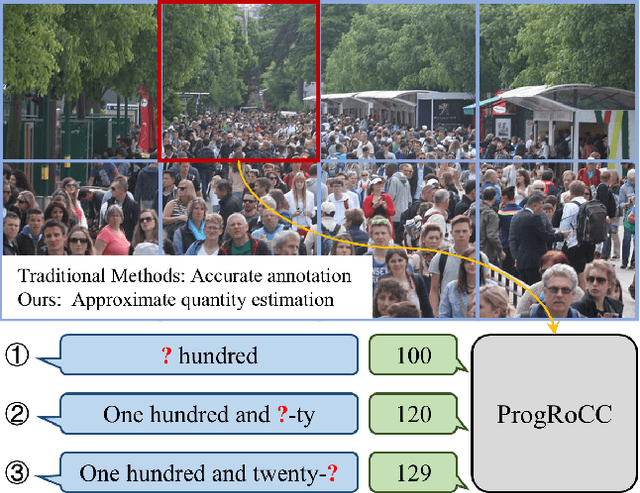
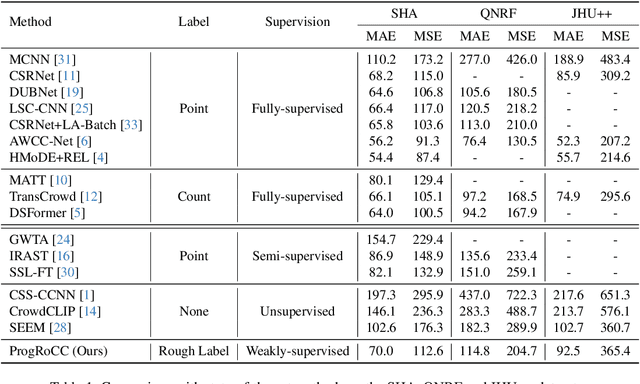
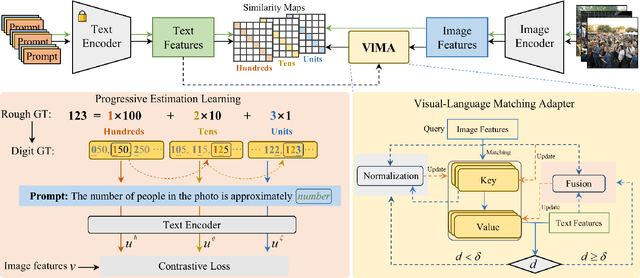

Abstract:As the number of individuals in a crowd grows, enumeration-based techniques become increasingly infeasible and their estimates increasingly unreliable. We propose instead an estimation-based version of the problem: we label Rough Crowd Counting that delivers better accuracy on the basis of training data that is easier to acquire. Rough crowd counting requires only rough annotations of the number of targets in an image, instead of the more traditional, and far more expensive, per-target annotations. We propose an approach to the rough crowd counting problem based on CLIP, termed ProgRoCC. Specifically, we introduce a progressive estimation learning strategy that determines the object count through a coarse-to-fine approach. This approach delivers answers quickly, outperforms the state-of-the-art in semi- and weakly-supervised crowd counting. In addition, we design a vision-language matching adapter that optimizes key-value pairs by mining effective matches of two modalities to refine the visual features, thereby improving the final performance. Extensive experimental results on three widely adopted crowd counting datasets demonstrate the effectiveness of our method.
REO-VLM: Transforming VLM to Meet Regression Challenges in Earth Observation
Dec 21, 2024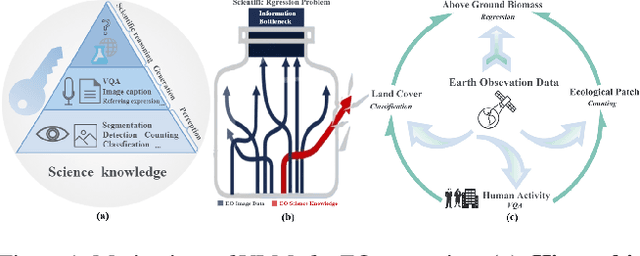
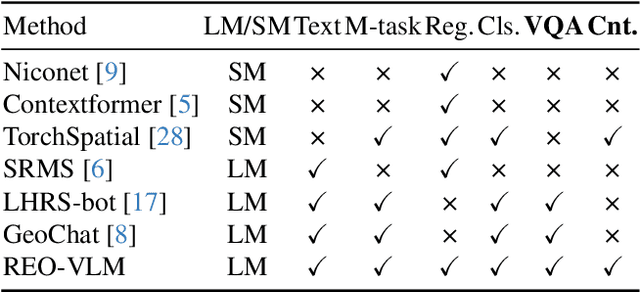

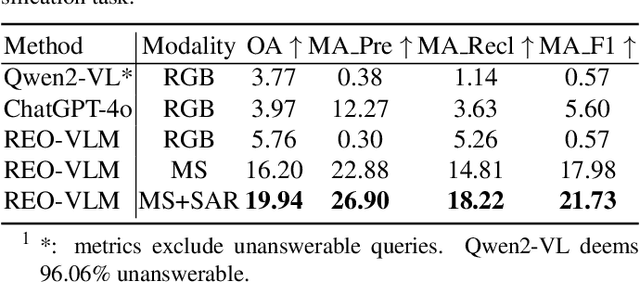
Abstract:The rapid evolution of Vision Language Models (VLMs) has catalyzed significant advancements in artificial intelligence, expanding research across various disciplines, including Earth Observation (EO). While VLMs have enhanced image understanding and data processing within EO, their applications have predominantly focused on image content description. This limited focus overlooks their potential in geographic and scientific regression tasks, which are essential for diverse EO applications. To bridge this gap, this paper introduces a novel benchmark dataset, called \textbf{REO-Instruct} to unify regression and generation tasks specifically for the EO domain. Comprising 1.6 million multimodal EO imagery and language pairs, this dataset is designed to support both biomass regression and image content interpretation tasks. Leveraging this dataset, we develop \textbf{REO-VLM}, a groundbreaking model that seamlessly integrates regression capabilities with traditional generative functions. By utilizing language-driven reasoning to incorporate scientific domain knowledge, REO-VLM goes beyond solely relying on EO imagery, enabling comprehensive interpretation of complex scientific attributes from EO data. This approach establishes new performance benchmarks and significantly enhances the capabilities of environmental monitoring and resource management.
Efficient Adaptation of Pre-trained Vision Transformer via Householder Transformation
Oct 30, 2024
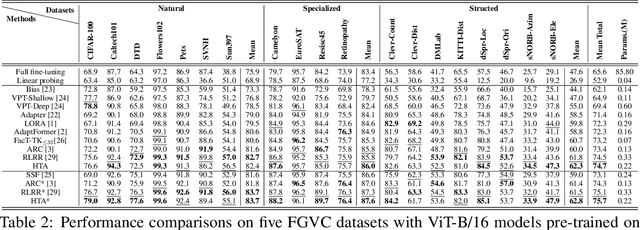

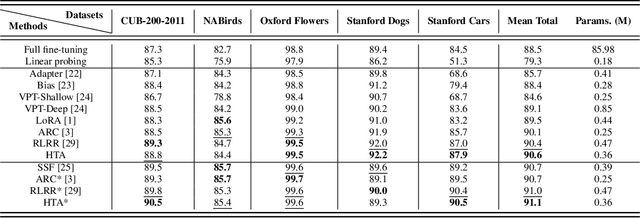
Abstract:A common strategy for Parameter-Efficient Fine-Tuning (PEFT) of pre-trained Vision Transformers (ViTs) involves adapting the model to downstream tasks by learning a low-rank adaptation matrix. This matrix is decomposed into a product of down-projection and up-projection matrices, with the bottleneck dimensionality being crucial for reducing the number of learnable parameters, as exemplified by prevalent methods like LoRA and Adapter. However, these low-rank strategies typically employ a fixed bottleneck dimensionality, which limits their flexibility in handling layer-wise variations. To address this limitation, we propose a novel PEFT approach inspired by Singular Value Decomposition (SVD) for representing the adaptation matrix. SVD decomposes a matrix into the product of a left unitary matrix, a diagonal matrix of scaling values, and a right unitary matrix. We utilize Householder transformations to construct orthogonal matrices that efficiently mimic the unitary matrices, requiring only a vector. The diagonal values are learned in a layer-wise manner, allowing them to flexibly capture the unique properties of each layer. This approach enables the generation of adaptation matrices with varying ranks across different layers, providing greater flexibility in adapting pre-trained models. Experiments on standard downstream vision tasks demonstrate that our method achieves promising fine-tuning performance.
Advancements in Visual Language Models for Remote Sensing: Datasets, Capabilities, and Enhancement Techniques
Oct 15, 2024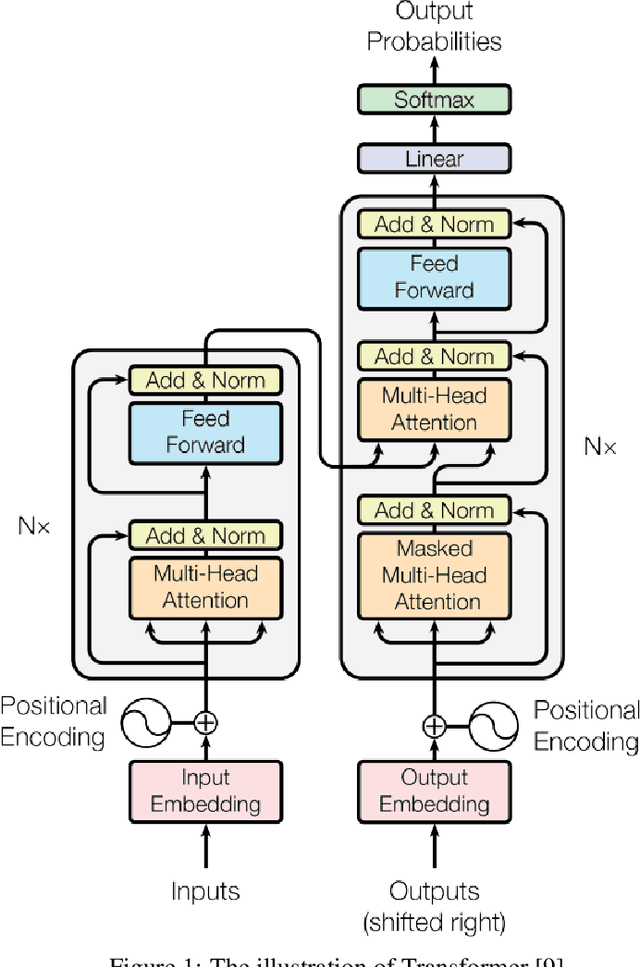
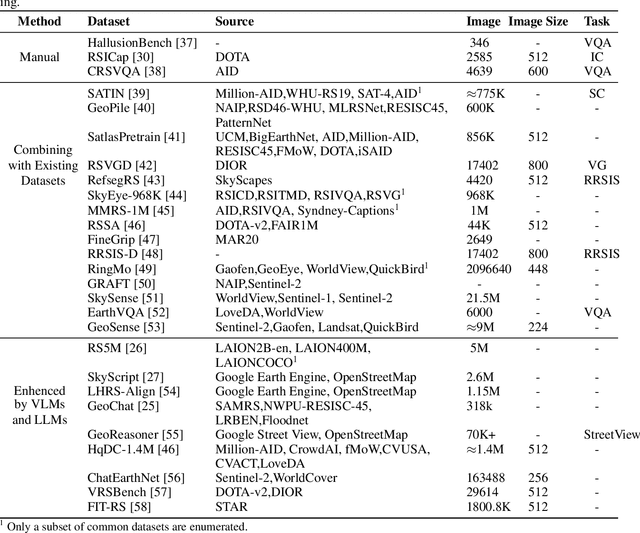
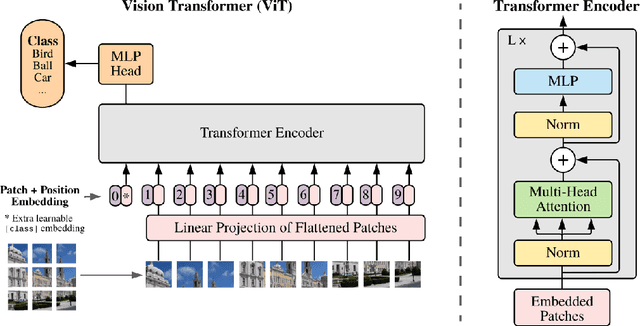

Abstract:Recently, the remarkable success of ChatGPT has sparked a renewed wave of interest in artificial intelligence (AI), and the advancements in visual language models (VLMs) have pushed this enthusiasm to new heights. Differring from previous AI approaches that generally formulated different tasks as discriminative models, VLMs frame tasks as generative models and align language with visual information, enabling the handling of more challenging problems. The remote sensing (RS) field, a highly practical domain, has also embraced this new trend and introduced several VLM-based RS methods that have demonstrated promising performance and enormous potential. In this paper, we first review the fundamental theories related to VLM, then summarize the datasets constructed for VLMs in remote sensing and the various tasks they addressed. Finally, we categorize the improvement methods into three main parts according to the core components of VLMs and provide a detailed introduction and comparison of these methods.
TG-LLaVA: Text Guided LLaVA via Learnable Latent Embeddings
Sep 15, 2024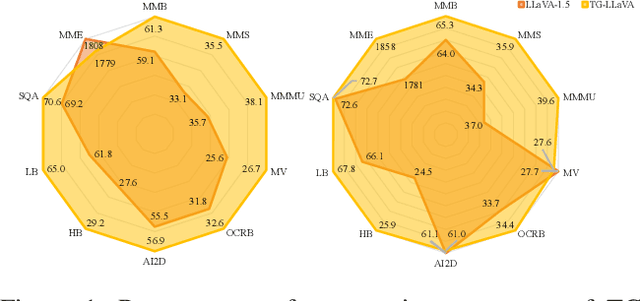
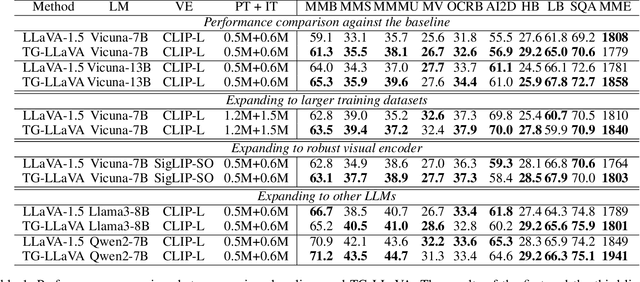
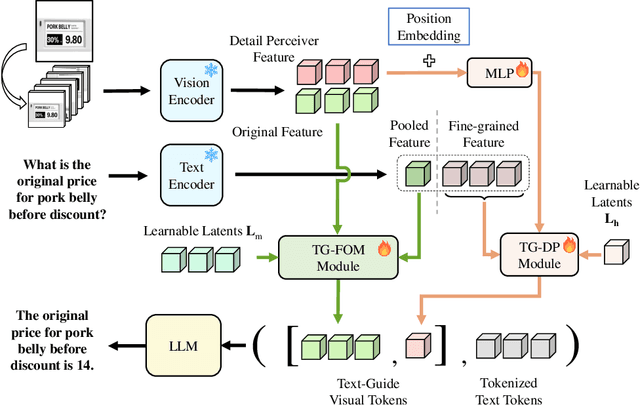

Abstract:Currently, inspired by the success of vision-language models (VLMs), an increasing number of researchers are focusing on improving VLMs and have achieved promising results. However, most existing methods concentrate on optimizing the connector and enhancing the language model component, while neglecting improvements to the vision encoder itself. In contrast, we propose Text Guided LLaVA (TG-LLaVA) in this paper, which optimizes VLMs by guiding the vision encoder with text, offering a new and orthogonal optimization direction. Specifically, inspired by the purpose-driven logic inherent in human behavior, we use learnable latent embeddings as a bridge to analyze textual instruction and add the analysis results to the vision encoder as guidance, refining it. Subsequently, another set of latent embeddings extracts additional detailed text-guided information from high-resolution local patches as auxiliary information. Finally, with the guidance of text, the vision encoder can extract text-related features, similar to how humans focus on the most relevant parts of an image when considering a question. This results in generating better answers. Experiments on various datasets validate the effectiveness of the proposed method. Remarkably, without the need for additional training data, our propsoed method can bring more benefits to the baseline (LLaVA-1.5) compared with other concurrent methods. Furthermore, the proposed method consistently brings improvement in different settings.
3D-RCNet: Learning from Transformer to Build a 3D Relational ConvNet for Hyperspectral Image Classification
Aug 25, 2024Abstract:Recently, the Vision Transformer (ViT) model has replaced the classical Convolutional Neural Network (ConvNet) in various computer vision tasks due to its superior performance. Even in hyperspectral image (HSI) classification field, ViT-based methods also show promising potential. Nevertheless, ViT encounters notable difficulties in processing HSI data. Its self-attention mechanism, which exhibits quadratic complexity, escalates computational costs. Additionally, ViT's substantial demand for training samples does not align with the practical constraints posed by the expensive labeling of HSI data. To overcome these challenges, we propose a 3D relational ConvNet named 3D-RCNet, which inherits both strengths of ConvNet and ViT, resulting in high performance in HSI classification. We embed the self-attention mechanism of Transformer into the convolutional operation of ConvNet to design 3D relational convolutional operation and use it to build the final 3D-RCNet. The proposed 3D-RCNet maintains the high computational efficiency of ConvNet while enjoying the flexibility of ViT. Additionally, the proposed 3D relational convolutional operation is a plug-and-play operation, which can be inserted into previous ConvNet-based HSI classification methods seamlessly. Empirical evaluations on three representative benchmark HSI datasets show that the proposed model outperforms previous ConvNet-based and ViT-based HSI approaches.
 Add to Chrome
Add to Chrome Add to Firefox
Add to Firefox Add to Edge
Add to Edge